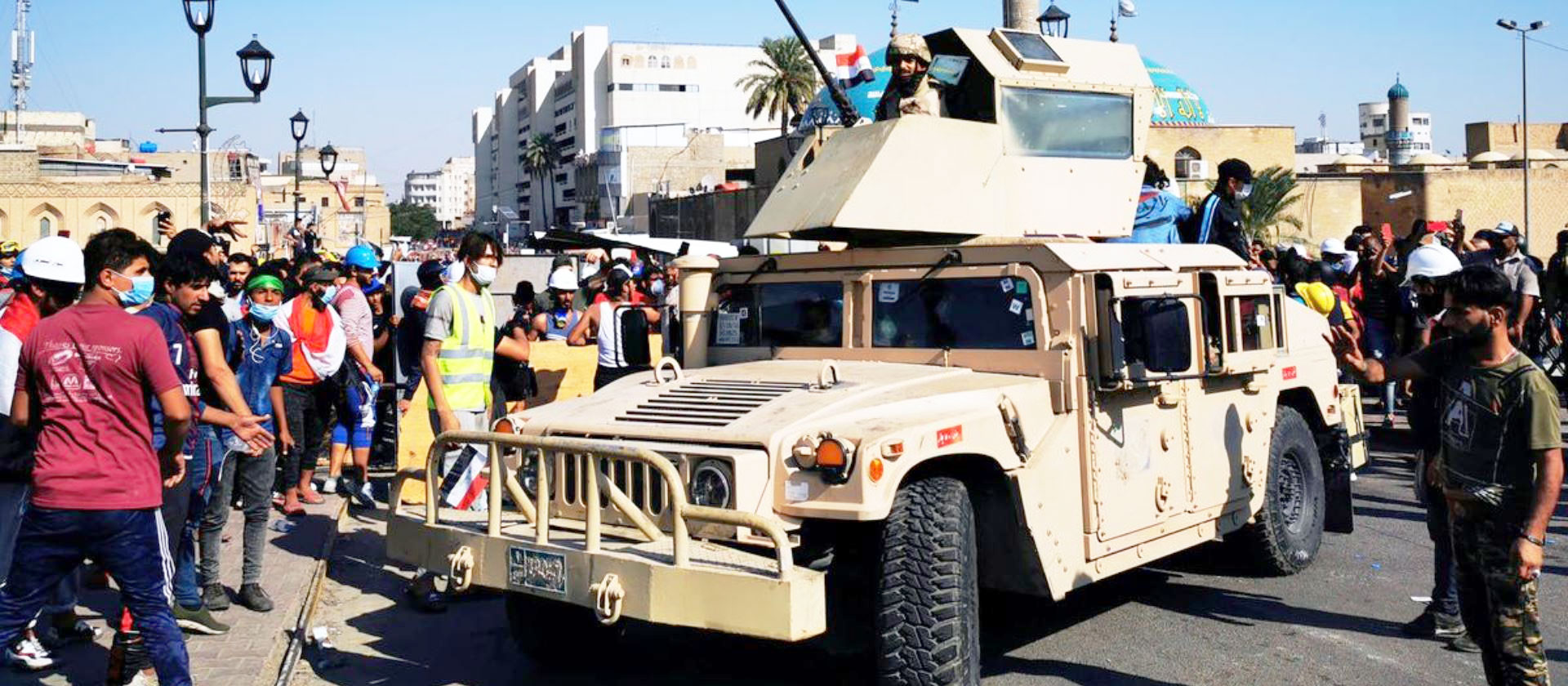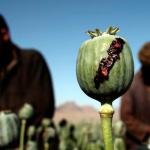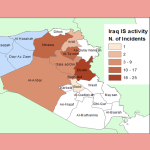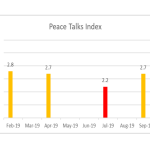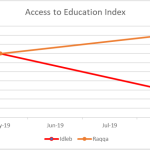Research Newsletter, #19 (November 2019)
Editor’s Note
The ongoing geopolitical competition in Syria and the wider Middle East is creating an enabling environment for the Is-lamic State (IS) and other transnational jihadis. Despite the death of its supreme leader, the Islamic State (IS) can only benefit from the latest US decision to withdraw its forces from Syria. Some members have already escaped detention in northern Syria, exploiting security gaps caused due to the political competition between major players in Syria . IS’s main competition in the re-gion is Hay'at Tahrir al-Sham (HTS), the group continues to fight Syrian troops in Idlib but an internal struggle between “hardline” and “moderate” factions may be looming.
Civil unrest has become central to insecurity in Iraq. In trying to defuse the threat of rising public anger, the GoI (Government of Iraq) started with an overreaction. Some 300 protesters have already been killed, a phenomenon that has re-ceived less coverage than a single casualty in the ongoing Hong Kong protests. The government has made few concessions but in what is a standard reaction of governments in such situations, at-tempts are being made to shift blame from the top to lower-level government functionaries. The recent changes may be followed by further changes within the GoI which means a likely cabinet reshuffle and/or purges within the security service. In the next phase, the opposition will likely make new demands, thus continuing the cycle of instability which appears to be spreading to Iran.
The Islamic State’s death and revival
The US’s sudden withdrawal from Syria sparked a long planned Turkish cross-border offensive in early October to drive Kurdish-led forces from the border region and create a “safe zone”. It recently halted its advance under a deal which involved the withdrawal from the border of Kurdish fighters. The US decision to withdraw from Syria and the Trump administration’s unpredictability in general has led to reconfigured alliances with Moscow emerging as the most effective powerbroker in the region.
In late October, IS leader Abu Bakr al-Baghdadi was killed in a US raid in northern Idlib, near the Turkish border. The next day, a drone strike killed Abu al-Hassan al-Muhajir, his likely successor. The strike took place near Jarablus, a border town controlled by Turkey-backed groups. The death of Al-Baghdadi temporarily weakens the group but the system built by Abu Musab Al-Zarqawi quickly accommodates to such circumstances. Pressure on the group continues, on November 9, unidentified airstrikes hit another ISIS compound west of Azaz, in a Turkish-controlled zone in northern Syria. The presence of IS leadership in areas near the Turkish border has raised questions about Turkish involvement but it is likely that Turkey’s focus on SDF and other Kurdish insurgent groups -not to mention the Assad regime- is the key to understanding this intelligence failure. Whatever the case, the current confusion in Syria affords IS more time to reinvigorate its auxiliary network and sleeper cells now under the command of its new leader Abu Ibrahim al-Hashimi al-Qurashi. It is telling that Baghdadi’s death was met with silence from many jihadi groups in Syria and Iraq, most notably Hay'at Tahrir al-Sham (HTS).
The US’s decision and the subsequent Turkish offensive impacted IS tactics, according to some sources, ISIS have claimed 30 attacks in the first 10 days of November - an increase of nearly 300% compared to the first days of October before the Turkish invasion. IS has also publicly gloated about the fate of Kurdish forces in the latest editorial of its weekly paper al-Naba where it describes allies betraying each other and changing allegiances and alliances while portraying IS itself the only stable, unchanging force. The offensive and the widening security vacuum in former ISIS territory has led to the freeing of some IS fighters’ families. The impact of the incursion on IS jailed fighters is still not fully known but according to Iraqi sources, dozens of ISIS operatives fleeing Syria have recently arrived in Iraq with their families. Most of these have arrived to the borders of Nineveh and Anbar province, before continuing to Salah al-Din, Kirkuk and Diyala, others arrived to Zammar, Rabia, Tal Baaj, Tal Afar and the borders.
This inflow of experienced fighters from Syria will increase overall group capacity and boost morale. Despite territorial losses and the death of Baghdadi, operational risks remain high in northern and central Iraq. IS has been active especially in the northern provinces and Anbar and attacks on energy infrastructure and security forces will continue well into 2020. It has continued attacking Shiites, such as the bombing of a bus carrying Shi'ites outside the holy city of Karbala, in late September. One Iraqi military officer interviewed by SAM said that IS have transitioned from attacking small checkpoints and military posts to attacking major army bases which indicates increased capacity. Attacks in Baghdad continue to be low yield IEDs and while there is no clear indicators of rising capacity, the Capital remains the main target of IS militants. ISIS fighters also continue to slip into Iraq from Syria, bolstering a low-level insurgency which is merging with other instability such as in Dara which is witnessing a significant increase in assassinations and attacks of all kinds. In its ongoing series of photo reports documenting fighters pledging to its new leader, IS featured the 'Hauran' division of Sham (Syria) Province based in Dara Governorate. The group also claimed detonating two explosives on vehicles carrying Russian and Syrian soldiers in early October in Northern Dara.
Battles are ongoing between the Syrian regime and an alliance of rebel groups led by Hay'at Tahrir al-Sham (HTS). These smaller battles could be the lead up to a larger effort by the Syrian army. In an interview with Russia Today, Syrian President Bashar al-Assad said that “the battle for Idlib will not take long,” signalling that the Syrian government is ready to consolidate its gains. HTS’s grip on Idlib may be weakening, civil unrest is increasingly being reported and the group is having to periodically conduct purges within its ranks, most recently against Faylaq al Sham a Muslim Brotherhood affiliated military alliance. For the time being, HTS propaganda is in damage control, celebrating inter-factional cooperation in recent battles against Syrian regime forces as well as boasting of financial and moral support from the local populace. In one video entitled “the Battle of Islam”, footage from other groups, including the National Front for Liberation and the HTS-aligned Jaysh al-Izza, are also incorporated into the video. An attack by the regime would in some sense be beneficial for HTS as it would likely lead to a closing of ranks with the population and other groups in Idlib.
Although it was once Al Qaeda in Syria, HTS has evolved into a pragmatic Salafi movement. While It still espouses an uncompromising stance for propaganda purposes, it has shown itself to be open to compromise including in negotiating with “apostate” regimes. A recently released video by HTS leader Jolani shows him adopting secular rhetoric mentioning the "Syrian revolution" as opposed to armed Jihad. This kind of positioning is anathema to the Islamic State and very controversial within HTS itself. As a movement, HTS has acted forcefully against IS, killing its members wherever it found them.
In turn, evidence has emerged that HaD has provided help to IS fighters who are enemies of HTS. A prominent AQ supporter recently dismissed reports of this logistical support following the discovery of a log of receipts from the IS' Khayr Province in Syria, showing payments of at least $67,000 to HaD for media equipment, security, and logistical expenses. HaD supports have referred to a communique from HaD leadership, Abu Hammas al-Shami and Sami al-'Arid which states that any member associating or communicating with IS will be immediately dismissed from the group. At the same time, the recent defection of an “extremist” wing of HaD is likely to indicate IS infiltration within HaD ranks. some respected commanders such as Abu Al-Abd Ashda'a, are publicly criticizing HTS which led to his arrest, and with demonstrations for and against the organization. Infighting will likely occur soon probably as a result of HTS overreaction to its political line.
Civil Unrest in Iraq
So far, the Iraqi Government response to civil unrest in Iraq has been violence and repression. The toll since the beginning of October stands at 300 killed and 150000 wounded across the country. The people doing the killing are from both the Iraqi security services and factions of the paramilitary Hashd al-Shaabi or Popular Mobilisation Forces (PMF) known to be aligned with Iran. There is no distinct boundary line divides the PMF, whom may number about 85,000. from state security institutions. Political parties in the dominant parliamentary bloc, Fatah Alliance, which is led by Hadi al-Ameri, head of the Iran-aligned Badr Organisation, are likely working to facilitate the PMF’s role in suppressing further dissent and this will likely entail centralising the command of the PMUs under Iran-aligned commanders, and even closer integration with regular units of the Iraqi security forces. Those managing the response to the protests at the highest level are all linked indirectly or directly to Iran and include the head of the Iranian Revolutionary Guard Corps- Quds Force, Qassem Soleimani, and several senior Iran-backed figures including PMF chairperson Falih al-Fayadh and the Ministry of Interior's Rapid Response Force commander (and former Badr member).
The heart of the protests remains in Baghdad. and there is an increasing likelihood that more violence and widespread arrests will be used to quell the protests. The government’s scapegoating of security officials for violence during protests is the first sign that the Government feels threatened and is ready to make concessions. Prime Minister Adil Abdul-Mahdi reportedly dismissed several security officials from their posts, including the head of Baghdad Operations Command, Jalil al-Rubaie. Government overreaction reflected in the targeted killing of protesters transformed unorganised rallies into a mass movement not far from a general uprising. While protests in Baghdad have taken center stage, protests in Diwaniyeh, the heartland of Shia Iraq, showing Iraqis destroying Images of Iran’s rulers (posters of Iranian Supreme Leader Ali Khamenei and IRGC Quds Force chief Qassem Soleimani) are unprecedented and unsettling for Teheran. Along with corruption, Iran med-dling is central to protesters’ anger. Pro-Iran elements are spreading conspiracy theories such as Qais al-Khazali, the leader of Asaib Ahl al-Haq, a powerful paramilitary faction was given almost two hours on Iraq's state TV channel to blame the protests on the US and Israel. To be sure, the US has publicly supported the protests and this situation is to its advantage but protests are much more a manifestation of Iraqi anger at the Government than anything to do with external manipulation.
Forecast
Forecast 1: Civil unrest in Iraq will likely continue unless signs of decreasing risks such as the resignation of Prime Minister Abdul-Mahdi or early elections are seen. Such a move would signal a shift to a reduced influence of Iran, a country dealing with its own civil unrest. However, there is a risk of fragmentation within the security forces due to the continued use of lethal force against protesters. This combined with resurgent sectarianism increases the risk of civil war. Civil unrest remains a significant threat across Iraq but also Syria. The country’s finances are already highly strained, and as the government becomes less able to import oil, social unrest becomes more likely.
Forecast 2: The risk of an Islamic State revival is growing. The IS insurgency will be steady with peaks and valleys for years to come. In the short term, the point for IS is now to prove it is still a threat after the death of Baghdadi. A large-scale attack in Baghdad is likely while lone wolf attacks are also likely in Western Europe or the United States. Insurgency and terrorist attacks, as well as Government reactions, will continue in Iraq and Syria. Most of this will consist of IEDs, attacks against infrastructure and official convoys, including the targeting of security officers. Such groups may still take advantage of instability should the civil unrest situation further deteriorate. Likely targets would be Shiite Mosques, police checkpoints and symbols of State power. A revival of the Islamic State that leads to renewed mass fatality attacks in Baghdad, would give PMFs and Iran-aligned groups further pretext for repression and is part of the group’s strategy.
Photo source: Globaldailymetro

